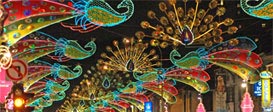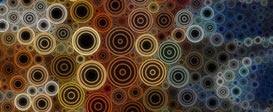Art Gallery: Synthesis - Toward A New Perception
- The Art Gallery submission deadline was 20 June 2008.
- Submission Rules
& Requirements: - Digital Performance
- Installations
- Monitor-Based Work
- Wall-Based Work
1. What type of artwork is acceptable for submission?
Broad categories of work are digital performance, installation, monitor-based, and wall-based work:
Digital Performance
- Electronically mediated performance
Digital art happenings, art events, or small-venue performances. - Trans-Forms (may apply to any of the broad categories)
Emerging trans-disciplinary, trans-cultural forms at the intersection of computing and the natural sciences, arts, and/or humanities. This could include creativity in the space between disciplinary fields such as, but not limited to: anthropology, architecture, biology, ethnographics, genomics, geography, history, linguistics, literature, nanotechnology, neuroscience, oceanography, painting, philosopy, physics, poetry, wireless and embedded systems, and world music.
Installations
- Art installations and environments
Electronically mediated spaces where the environment is part of the work of art. Includes experimental interactive music and digital sound environments. - Art sculptures and objects
Sensor-driven art, robotics, found-object art, constructed interfaces, artists' books. - Trans-Forms (See description under Digital Performance)
Monitor-Based Work
- 4D (time-based) work
This category is for flat work that is projected or hung on a wall, that moves or evolves over time, and that requires a viewing experience in a gallery setting. Work that requires a theatrical setting should be submitted to the Computer Animation Festival. - Digital communities
Screen-based work, database art, web art, generative art, interactive programs, games, open-source narratives, interactive film, distributed social networks. - Interactive art, including CD-ROM, DVD ROM, and web-based work
- Trans-Forms (See description under Digital Performance)
Wall-Based Work
- 2D still images
Digital painting, digital imaging, prints, and mixed-media works. - 3D still images
Still-image artwork created using 3D software or algorithms. - Trans-Forms (See description under Digital Performance)
If your work does not obviously fit into one of these categories, please choose the one that seems most appropriate. Your work will not be rejected because it does not conform to one of these categories.
2. My work has an aesthetic component, but it is mainly a demonstration of a technology I developed. Where should I submit it?
Please submit it to Emerging Technologies.
3. Explain what "4D wall-based" means.
This is work that is projected or hung on a wall, that moves or evolves over time, and that requires a viewing experience in a gallery setting. Work that requires a theatrical setting should be submitted to the Computer Animation Festival.
An example of a 4D artwork would be a framed plasma monitor or a touch screen that is hung on the wall. This type of work may require an electrical outlet or an input device.
4. My piece has moving images on a flat-panel display that is intended to be hung on a wall. Should I submit it as Wall-Based Work or as Monitor-Based Work?
It should be submitted as Wall-Based Work.
5. What is the difference between Interactive Installation and Interactive Performance, and how should I submit a work that combines them?
We realize that there are many crossovers between these two categories, but in general if a performer interacts and the audience or public observes, then it is an interactive performance. If the audience or public interacts and there are no performers, then it is an interactive installation. If your project is a combination, you should submit your work in the category that fits best and be sure to explain in detail the technical, space, and any other requirements for it.
6. If I am interested in submitting an electronically mediated performance, what sort of limitations should I be aware of?
The SIGGRAPH ASIA 2008 Art Gallery welcomes proposals for all kinds of electronically mediated performances. However, we will not be able to present all deserving projects due to limitations in availability of suitable venues. Your performance should be no longer than one hour in length, and you should be able to repeat the performance at least twice during the conference. You will be responsible for all set-up and tear-down (we will provide volunteers to help). You are also responsible for supplying your own equipment. If you have a performance that does not fit well into these parameters, please contact the Art Gallery Chairs to discuss possible solutions. There may be other opportunities for you at SIGGRAPH ASIA 2008.
7. Can I submit a video documenting my work?
For performances, installations, and any interactive art that changes over time, you should submit a digital video that shows the evolution of the work. Still images do not need video documentation.
8. I have an art animation. Where do I submit it?
Submit all animations to the Computer Animation Festival.
9. Is digital video art accepted?
Yes, if there is a significant use of creative digital techniques to alter the video, if the piece incorporates computer animation, or if it expands on aesthetic issues described in the Art Gallery Call for Participation.
10. Is SIGGRAPH Asia 2008 accepting sculptures?
Yes. We especially encourage sculptures that are interactive, robotic, electronic, or part of an installation. Rapid prototyping, works that make use of embedded systems, or works that combine traditional media with digital systems are also welcome.
11. Where do I send my submission materials?
All work must be submitted via the SIGGRAPH Asia 2008 online submission system. Do not send printed proposals or slides in physical form through the mail.
12. How many pieces can I submit to the SIGGRAPH Asia 2008 Art Gallery?
There is no limit. Submit as many as you like. But you must complete and submit a separate submission form for each work, unless your work is a series (see below.)
13. If my work is a series, how should I submit it?
You should submit all pieces of the series under the same submission form. Be aware that if you specify that the pieces can NOT be split up, the jury will have to agree on all of the works in the series, so the work may be harder to accept. If your series does not hold together without each of the component parts, make sure you check "Please do not split up." Do not use this category to submit multiple artworks unless they are a series.
14. Can I submit a detail of my artwork along with the image?
Yes.
15. Will you accept my work without an artist's statement?
No. All submissions must include a 200-300 word publishable artist's statement. Your statement must address the conceptual aspects of the work. You must also include a 100-200 word publishable technical statement. You can find examples of artist's statements here.
16. Can I submit a URL rather than the images of my work?
No. You must submit images of your work so that we can publish an image of your work in the SIGGRAPH Asia 2008 Electronic Art and Animation Catalogue. You may submit a URL so that we can get additional information about your work if needed.
17. Will SIGGRAPH Asia 2008 pay for shipping and framing?
No, you are responsible for framing (NO glass, please), crating, shipping, and in-transit insurance. You must pack and ship your artwork professionally and safely. Packing peanuts are NOT acceptable. Work that arrives at SIGGRAPH Asia 2008 in substandard condition may be pulled from the show.
18. If my 2D or 3D still artwork is accepted, how should I frame it?
Please see Framing Artwork. You must present your artwork professionally. All framing should use Plexiglas. We reserve the right to pull works that are not framed to our specifications. If the presentation of your piece differs significantly from our description, it is your responsibility to contact us to discuss this matter before shipping your piece.
19. I have an over-sized work that I just want push-pinned to the wall. Is this acceptable?
No. Your work must be professionally framed. We reserve the right to pull works that are not framed to our specifications.
20. Can I display a visual postcard with my work on it in the art gallery?
Yes. Each artist will be encouraged to send or bring 4.25-cm x 6-cm color postcards with an image of the work on the front and information about the piece on the back. These will be displayed and available for attendees (so bring plenty). No commercial promotional materials will be allowed.
21. Will SIGGRAPH Asia 2008 pay for any duty or taxes on international shipments?
No. You are responsible for all import and export expenses.
22. Does SIGGRAPH Asia 2008 have funding to ship my equipment to the conference?
No. Many artists who have participated in previous SIGGRAPH Art Galleries have received funding from local arts organizations or national councils. We will be happy to provide a letter of reference should you require it.
23. If I show my work at SIGGRAPH Asia 2008, will I have to watch my equipment?
Yes. You will need to have enough people to watch your installation or art piece if it requires monitoring.
24. Do I need to install my own work?
If you have a 2D image that hangs on the wall, SIGGRAPH Asia 2008 will professionally hang your work for you. If you have an installation or other complex piece, you are responsible for installation and dismantling.
25. Will SIGGRAPH Asia 2008 pay for my accommodations and travel expenses?
No. You are responsible for your own expenses.
26. Can I submit to more than one program at SIGGRAPH Asia 2008?
Yes, but submit different works to each program.
27. Can I submit the same piece to multiple programs?
No. Submit your work to the program you feel is most appropriate.









